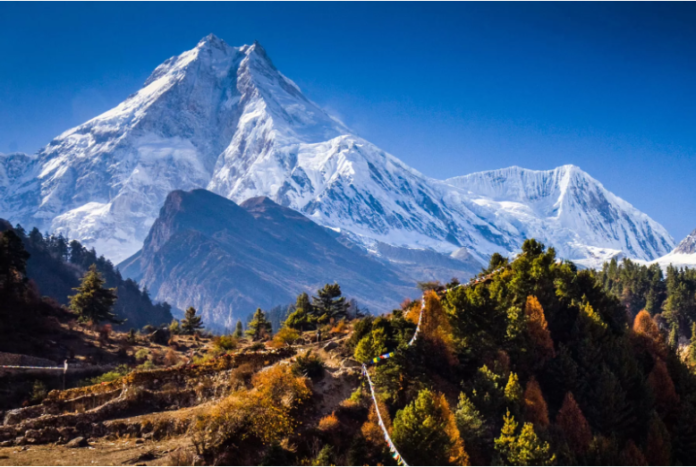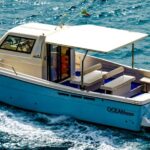Tucked away in the shadow of the towering Himalayas, far from the crowded paths of Everest and Annapurna, lies a lesser-known but incredibly rewarding trekking route: the Manaslu Circuit Trek. This off-the-beaten-track journey offers an unforgettable adventure through secluded valleys, age-old Buddhist settlements, and towering mountain passes, all set against the backdrop of Mt. Manaslu — the eighth-highest peak on Earth.
For those yearning for a trekking experience that’s both rugged and culturally rich, the Manaslu Circuit is the perfect expedition.
A Route Less Traveled
Starting from the lowland village of Soti Khola, the trail ascends gradually into the high Himalayas, following the path carved by the Budhi Gandaki River. Over the course of two to three weeks, trekkers traverse landscapes that change dramatically—from lush green forests and cascading waterfalls to snowy ridges and barren alpine plateaus.
Compared to the more commercialized trekking regions, Manaslu feels raw and untamed. The journey is challenging but immensely rewarding, drawing adventurers who seek both solitude and the thrill of high-altitude exploration.
The Cultural Pulse of the Manaslu Region
What sets the Manaslu Circuit apart isn’t just the scenery—it’s the people. Along the way, you pass through remote communities where daily life continues much as it has for centuries. Villages like Lho, Samagaun, and Samdo offer a rare glimpse into a world where Tibetan customs and Buddhist traditions dominate daily life.
Prayer flags dance in the wind, stone mani walls line the paths, and ancient monasteries stand watch over the valleys. You’ll hear the soft hum of monks chanting in the evenings, and perhaps even be invited in for a cup of butter tea. It’s a journey into a living, breathing culture — not a museum or a tourist show.
High Passes and Himalayan Vistas
One of the trek’s most thrilling moments comes when you cross the Larkya La Pass, perched at an altitude of 5,160 meters. This is the highest point of the trek, and arguably its most dramatic.
The climb to the pass is demanding, especially in thin air, but once at the top, the reward is unmatched: a sweeping panorama of Himalayan titans like Cheo Himal, Himlung, Kang Guru, and the distant peaks of the Annapurna range. The descent on the other side, often covered in snow, adds an extra sense of adventure to the trek.
Permits and Trekking Requirements
Due to its remote location and proximity to the Tibetan border, the Manaslu region is a restricted trekking zone, which means you’ll need a few official documents to enter:
- A Restricted Area Permit (RAP) for Manaslu
- A Manaslu Conservation Area Permit (MCAP)
- An Annapurna Conservation Area Permit (ACAP) for the exit route
Solo trekking is not allowed in this region. You must be accompanied by a registered guide, and you need to be part of a group of at least two trekkers (though agencies often help solo travelers join groups).
Best Time to Visit
The most favorable seasons for the Manaslu trek are:
- Autumn (September to November): Crisp air, dry weather, and clear skies make this the most popular time.
- Spring (March to May): Rhododendrons bloom in the lower forests, and the weather is generally stable.
Monsoon months (June to August) bring slippery trails and leeches, while winter (December to February) can turn the high pass into a dangerous crossing due to snow and extreme cold.
Where You’ll Sleep and Eat
Unlike camping-based treks of the past, today the Manaslu Circuit has a well-established network of teahouses—basic lodges run by local families. These offer twin rooms with simple bedding and communal dining areas with warm stoves.
Meals typically include dal bhat (rice with lentil soup), Tibetan-style noodles, fried rice, or pancakes. The food is hearty and energy-rich—just what’s needed after long days of hiking.
Packing and Preparation
Preparation is key for a successful trek. Since the trail includes remote sections and extreme altitude, here are some essentials you’ll need:
- Layered clothing for temperature changes
- A good quality sleeping bag (especially in colder months)
- Trekking poles for stability on uneven ground
- Water purification methods (tablets, filter, or UV purifier)
- Snacks and personal medications
- Altitude sickness prevention meds like acetazolamide (consult a doctor)
You may also consider hiring a porter to carry heavier gear, which allows you to enjoy the trek without overexerting yourself.
A Journey Through Nature’s Masterpiece
One of the most powerful aspects of the Manaslu Circuit is the sheer variety in landscape. One day you’re walking through dense forest teeming with monkeys and birds, the next day you’re stepping through snow in a high-mountain desert.
The conservation area is home to a range of wildlife, including blue sheep, Himalayan Tahr, and if you’re extremely lucky (and quiet), even the elusive snow leopard. The plant life changes just as drastically, with rhododendrons, bamboo, and pine giving way to alpine moss and lichen as you ascend.
Why the Manaslu Circuit Deserves More Attention
Despite being overshadowed by more famous treks, the Manaslu Circuit delivers on all fronts: natural beauty, cultural immersion, physical challenge, and deep personal satisfaction. It’s demanding, yes—but also deeply rewarding.
In a time when many trekking routes are becoming increasingly commercialized, Manaslu offers something rare: a genuine wilderness experience paired with human connection. It’s not just a walk through the mountains—it’s a walk through history, culture, and your own limits.
In the end
If you’re in search of a Himalayan adventure that combines raw nature, vibrant culture, and fewer crowds, the Manaslu Circuit Trek is an outstanding choice. With proper planning and a spirit of exploration, this lesser-known circuit will leave you with stories, memories, and perhaps even a new perspective on what it means to truly journey.










